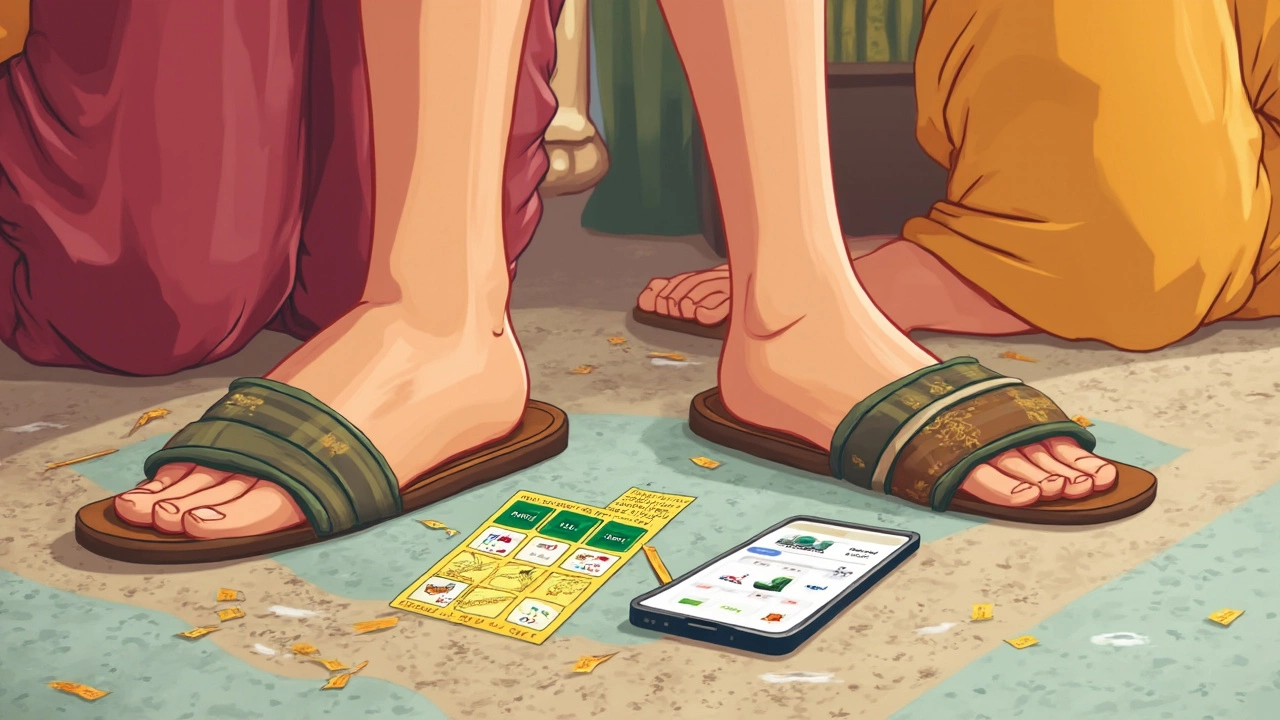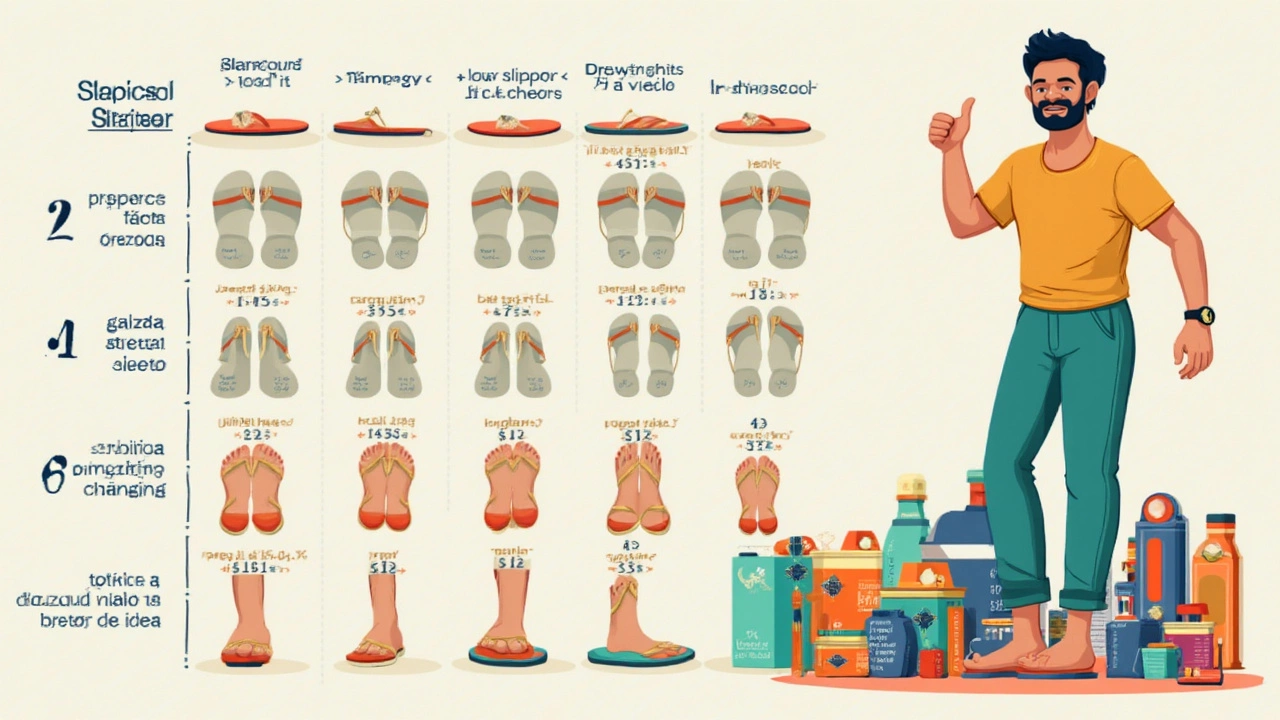Are Slipper Sizes the Same as Shoe Sizes? Your Fit Guide

You’d think grabbing a pair of slippers in your usual size would be a no-brainer. But here’s the thing—slipper sizes don’t always line up perfectly with your regular shoes. This catches a ton of people off guard, and suddenly you’re shuffling through the house in slippers that flop off or pinch your toes.
Slippers are usually designed for comfort, not the snug, structured fit you expect from sneakers or boots. Manufacturers often use looser sizing or flexible materials, which can make them feel bigger or smaller than your true shoe size. Sometimes, slipper sizes are just “small, medium, large,” instead of actual numbers, adding more guesswork to the mix.
- Slipper Sizes vs. Shoe Sizes: What's the Difference?
- Why Fit Feels Different in Slippers
- Common Sizing Pitfalls and How to Avoid Them
- Tips for Choosing the Right Slipper Size
- What to Do When Slippers Don't Fit Right
Slipper Sizes vs. Shoe Sizes: What's the Difference?
It’s easy to assume your slipper size matches your regular shoe size, but brands throw in all kinds of quirks that can leave you with a sloppy or squeezey fit. Here’s the basic issue: slippers are designed for lounging, not pounding the street, so the sizing isn’t always as strict or standardized.
Most shoe brands go by specific foot measurements—a size 8 shoe is meant to fit a certain length and width down to the millimeter. Slippers, on the other hand, are often cut with extra wiggle room, stretchy materials, or soft linings. This means a size 8 slipper could feel bigger, smaller, or totally different compared to your sneakers or boots.
Some slipper brands don’t even use number sizing. Instead, you might see things like small, medium, large, or combined size ranges (like "8-9" for women). That’s helpful for gift buying but can make it tricky to get the fit right on the first try.
Let’s look at how this plays out across brands. Here’s a quick sample of typical slipper sizes versus shoe sizes:
| Women's US Shoe Size | Slipper Size (Brand A) | Slipper Size (Brand B) |
|---|---|---|
| 6-7 | S | 5-6 |
| 8-9 | M | 7-8 |
| 10-11 | L | 9-10 |
Brand A uses "S/M/L" sizing, while Brand B combines two shoe sizes into one slipper size. Just switching brands can mean your usual size won’t fit the same way.
If you’re buying online, always check sizing charts specific to each brand. Slippers run small, big, or true-to-size depending on materials, style, and country of manufacture. A good tip: if you’re between sizes, most folks find it comfier to size up, especially with closed-back slippers where you don’t want your heel dangling off the edge.
Why Fit Feels Different in Slippers
Ever wondered why your trusty size 8 feels just right in sneakers but downright loose in slippers? There’s an actual reason for that. Slippers are usually built for pure comfort, often with wider designs, softer interiors, and stretchy materials. Because of these factors, the fit of slippers almost always feels roomier than your go-to shoes.
Let’s break down what really sets slippers apart:
- Material: Most slippers use plush linings (like fleece, memory foam, or faux fur) that flatten and mold to your feet over time. Structured shoes don’t have this much give.
- Design: Open backs, rounded toes, and slip-on construction make them less structured—so your foot slides and shifts more freely inside them.
- No laces or fasteners: Unlike shoes you can tighten, slippers rely totally on their shape and softness for fit.
- Sizing systems: So many slipper brands use S/M/L instead of numbered sizes. One brand’s "Medium" could mean a women's 7-8, while another calls the same thing a 6-7.
To make it even clearer, here’s a simple snapshot comparing how slippers and shoes typically differ by fit:
| Typical Shoes | Slippers | |
|---|---|---|
| Fit | Snug, supportive | Loose, relaxed |
| Materials | Stiff soles, firm uppers | Soft foam, knits, fuzz |
| Heel support | Structured, closed-back | Open back or less support |
| Sizing | Numerical (precise) | S/M/L (vague) |
| Stretch Factor | Little stretch | Molds to foot, stretches with use |
Bottom line: That easygoing slipper fit is great for relaxing but can throw you off if you expect *slipper sizes* to match your everyday shoes. Always check the sizing chart, especially for brands you haven’t tried before. If your foot runs narrow or wide, that loose fit could feel even more exaggerated—or have you sliding right out of them.

Common Sizing Pitfalls and How to Avoid Them
Here’s the reality: it’s super easy to wind up with slippers that don’t fit quite right. The biggest trouble comes from sizing that's less precise than what you'd expect with regular shoes. You see "medium," but what does that actually mean? Even numbered sizes can be inconsistent, depending on the brand or where they're made.
Here’s a quick table showing what different brands mean by basic slipper sizes in the US. Look how the numbers overlap:
| Brand | Small | Medium | Large | XL |
|---|---|---|---|---|
| Dearfoams | 5-6 | 7-8 | 9-10 | 11-12 |
| Isotoner | 5-6.5 | 7-8 | 8.5-9.5 | 10-11 |
| L.L.Bean | 5-6 | 7-8 | 9-10 | 11-12 |
This overlap means if you’re a size 8.5, you could fall into either “medium” or “large,” depending on the brand. No wonder there’s so much confusion, right?
- slipper sizes can run big or small, sometimes up to a full size difference from shoes.
- Fuzzy linings can flatten over time, making a slipper that feels snug at first feel way too loose after a couple weeks.
- Open-back vs. closed-back styles fit differently—a backless slipper is more forgiving, but can easily slide off the heel if it's too big.
- Many people ignore width. Some slippers are made pretty narrow, so wide feet often feel squished. Always check if a wider option is offered.
If you’re shopping online, scroll for the brand’s own size chart. Sites like Zappos or Amazon often include a “fit runs large/small” note based on customer reviews. Read those—the crowdsourcing really helps.
To sum up: sizing isn’t just about length. Pay attention to width, shape, and the kind of lining. When in doubt, measure your foot and compare against the specific chart for the brand. You’ll save yourself a return (or two).
Tips for Choosing the Right Slipper Size
Getting the right slipper fit is trickier than you’d think. First, don’t just guess—measure your foot if you haven’t in a while. Your foot shape can change over time thanks to things like age, pregnancy, or even just spending a lot of time on your feet.
Brands aren’t always consistent, and sometimes a size 8 slipper will fit more like a 7.5 or a 9, depending on the style and material. If a brand has a size chart, actually use it. Line up your measurements with their chart because that’s usually more reliable than just ordering your shoe size and hoping for the best. Here’s a quick example of how slipper sizing stacks up to general foot length in inches:
| US Slipper Size | Foot Length (inches) | Typical Fit |
|---|---|---|
| 6 | 8.875" | Snug |
| 7 | 9.25" | Standard |
| 8 | 9.625" | Comfy |
Pay attention to the slipper sizes listed—some brands run small, some run large. Read reviews if you can. People are honest about whether slippers run true to size, and their feedback is gold.
- If you’re between sizes, it’s often safer to size up, especially with closed-back slippers.
- For open-back styles (like slip-ons), you might want a snugger fit so your heel doesn’t slip out.
- If you plan on wearing thick socks, definitely factor that into your choice and measurements.
If you’re shopping for someone else, stick to adjustable options like those with velcro or stretch panels. They handle foot width or swelling way better than stiff, tight slippers.
Return policies matter, too. Most brands accept returns or exchanges for slippers—but check before you buy, just in case that "perfect" size needs a swap.

What to Do When Slippers Don't Fit Right
So you tried your new slippers and they’re either flopping around or squeezing your feet. Don’t panic—this honestly happens to a lot of people. Here’s what you can do to fix it without tossing them in the back of your closet.
If your slippers are too loose, start with the basics. Some people fix this by wearing thicker socks. It’s simple and works, especially in colder weather. If that’s not enough, try adhesive heel grips or cushioned insoles. These add padding and help your heel stay in place.
When slippers are too tight, things get trickier. Check if your slippers are made with leather or fabric, since some materials can stretch a bit over time. You can gently stretch tight fabric slippers at home by wearing them with thick socks for short periods or warming snug spots with a hairdryer (always careful, don’t overdo it!). With non-stretchy materials like rubber, though, you’re out of luck—it might be time for a different size or style.
If you ordered online, check the return or exchange policy right away. Most big brands let you swap sizes if you act quickly and keep the slippers in resale shape. Save your receipts and original packaging until you’re 100% sure about the fit.
- slipper sizes often run smaller or larger, depending on brand and style, so don’t be afraid to try up or down a size.
- Brands sometimes update their sizing, so check reviews for fit tips before a new purchase.
- If all else fails, some local cobblers or shoe repair shops can adjust certain slippers, especially leather ones.
Your comfort isn’t a lost cause. A few tweaks or a return can make sure your slippers are actually relaxing—which is the whole point, right?
- May, 14 2025
- Violet Greenfield
- 0
- Permalink
Written by Violet Greenfield
View all posts by: Violet Greenfield